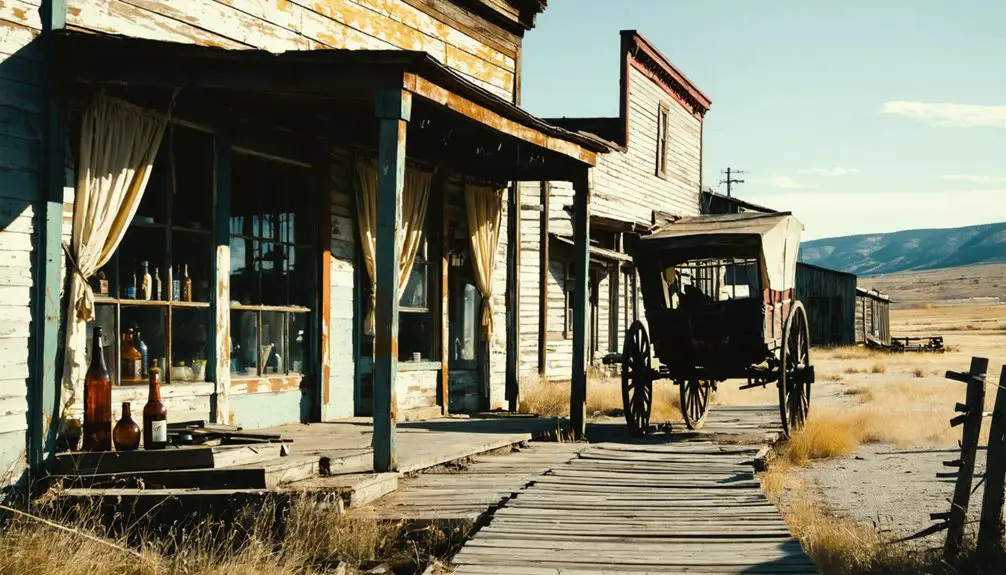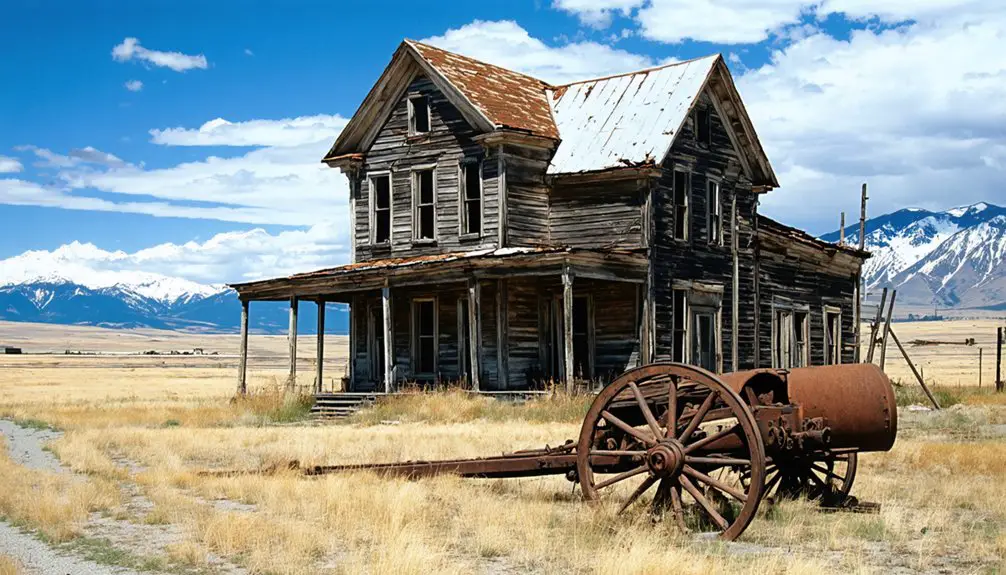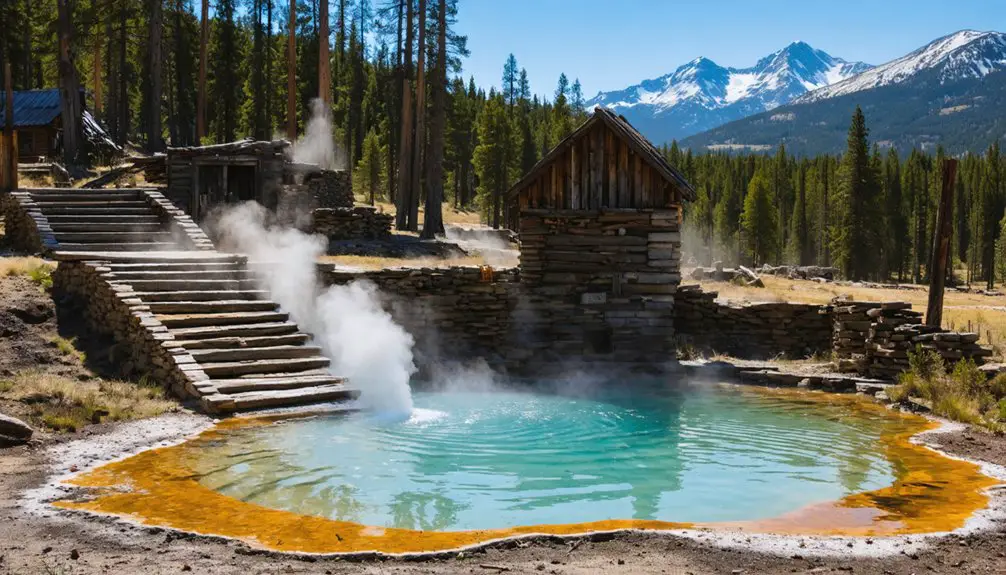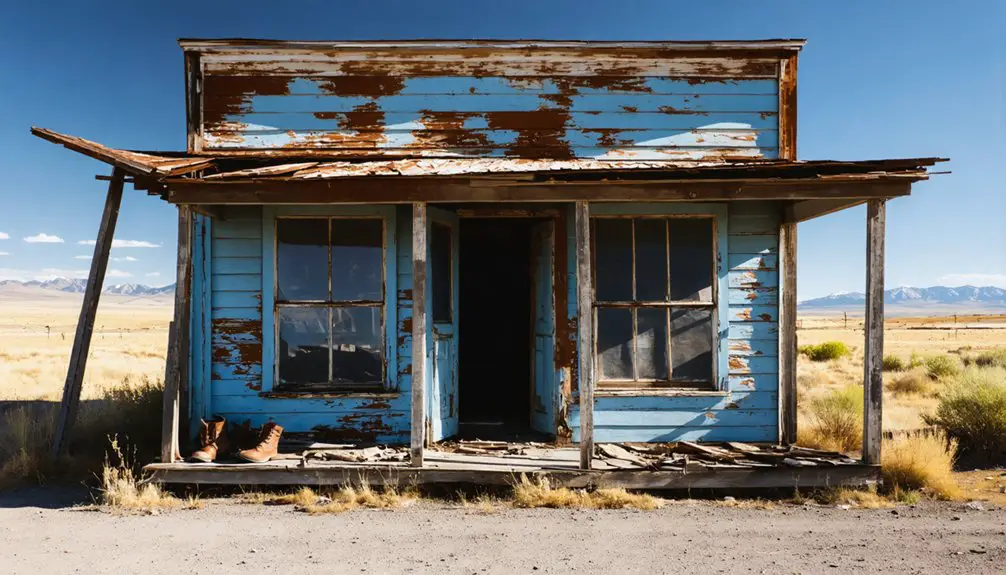You’ll find Chico’s ghost town in Montana’s Paradise Valley, where gold discoveries in 1863 sparked a thriving settlement. Originally established as Yellowstone City, residents relocated to form Chico after conflicts with Crow Indians. Unlike typical mining towns, Chico banned saloons, focusing on family-friendly amenities and essential services. Today, you can explore two dozen weathered buildings and the historic Chico Hot Springs resort, where therapeutic waters and mining heritage intertwine to tell a fascinating frontier tale.
Key Takeaways
- Chico originated as a gold mining settlement in 1866 after residents relocated from Yellowstone City due to conflicts with Crow Indians.
- The town flourished with 300 residents by 1874, distinguished by its family-friendly atmosphere and absence of saloons.
- Today, about two dozen historic buildings remain standing, including a general store, school, and boarding houses.
- The discovery of Chico Hot Springs in 1900 transformed the mining town into a wellness destination that continues operating.
- Gold mining operations, which produced over $304 million since 1865, defined the town’s early economy before its decline.
The Birth of a Mining Settlement
When gold was discovered in the Chico area in 1863, it sparked a rush of mining activity that would establish Yellowstone City as the region’s first settlement.
By 1865, you’d have found 75 log houses and roughly 200 residents carving out their existence in this frontier outpost. Cultural influences emerged as miners from passing wagon trains settled in, bringing their dreams of striking it rich. A post office opened 1874 to serve the growing community.
However, economic shifts came swiftly when harassment from Crow Indians forced settlers to abandon Yellowstone City by late 1865.
Persistent conflict with Crow tribes disrupted the fledgling settlement, compelling Yellowstone City’s residents to seek safer ground elsewhere.
The community’s pioneering spirit wouldn’t be extinguished – they simply relocated closer to Emigrant Gulch, establishing the new town of Chico. The name itself reflects the area’s diverse heritage, credited to a young Mexican traveler in 1866 who left his mark on this rugged Montana landscape. By 1874, the town had grown substantially as the population reached 300 residents.
Life Without a Saloon: A Unique Mining Town
Unlike the typical rowdy frontier settlements of Montana Territory, Chico stood apart as a mining town that never housed a saloon within its borders. This unique aspect of Chico’s social structure reflected distinct community values that shaped daily life in the settlement.
You’ll find that instead of drinking establishments, the town focused on developing essential services like a school, general store, and two boarding houses that served both locals and visiting miners. Originally established by miners from Yellowstone City, the settlement maintained its commitment to creating a family-friendly environment.
When Percie Knowles established medical facilities in the early 1900s, she maintained this alcohol-free tradition while advancing the town’s healthcare services. Today, the historic property sits in the shadow of Emigrant Peak as a testament to its enduring legacy.
The absence of saloons didn’t hinder Chico’s growth – residents adapted by diversifying into farming and embracing tourism opportunities, particularly after the opening of Chico Hot Springs boarding house in 1900.
Gold Rush and Mining Operations
You’ll find that Chico’s mining history began in 1863 when gold discoveries prompted the establishment of nearby Yellowstone City, which later relocated to present-day Chico due to conflicts with the Crow.
The area proved to be incredibly rich in precious metals, producing over $304 million in gold since 1865.
Early operations attracted many Cornish immigrant miners who brought their extensive mining expertise to the region.
As mining methods advanced through the late 1800s, operations expanded to include sophisticated equipment like the ten-stamp mill and Blake Crusher, making ore processing more efficient.
The St. Julian Mine, opened in 1887, proved particularly lucrative with its impressive yield of $360 in gold and $40 in silver per ton, helping to establish Chico as a significant mining settlement in Montana’s history.
Discovery and Early Days
Following the discovery of gold in 1863 near Emigrant Gulch, the Chico area quickly transformed from untamed wilderness into a bustling mining district. The gold rush brought waves of prospectors who staked mining claims throughout the region, focusing their efforts on the rich placer deposits that promised quick fortunes.
You’ll find that the area’s first settlement, Yellowstone City, emerged as miners flocked to the region in 1864. However, persistent harassment from Crow Indians forced the settlers to abandon this location by 1865.
Undeterred, the resilient miners established a new settlement closer to their mining operations – the town of Chico. This strategic move allowed them to consolidate their efforts around Emigrant Gulch, where they’d continue to extract precious metals for decades to come. The miners frequently visited the natural hot springs to soothe their aching muscles after long days of work. The Chico Warm Springs Hotel was built in 1900, providing comfortable lodging for forty weary travelers and workers.
Mining Methods Evolve
As placer gold discoveries sparked Chico’s initial growth, mining methods rapidly evolved from simple panning operations to increasingly sophisticated techniques.
You’d have seen miners first working creek beds by hand, using basic placer techniques to separate gold from gravel.
St. Julian Mine Impact
The St. Julian Mine transformed Chico’s economic landscape when it opened in 1887, yielding an impressive $360 in gold and $40 in silver per ton. You’ll find this mine’s impact went far beyond its rich ore deposits, fundamentally shaping the region’s development and St. Julian’s economics.
Situated at 8,399 feet elevation, the mine’s remote location presented unique operational challenges. Located in the Emigrant Creek District, the mine exemplified the rich mineral potential of Park County, Montana. As operations expanded, the mine’s infrastructure grew to include a ten-stamp mill by the 1890s, followed by a 12-stamp mill equipped with advanced machinery in 1904. This investment demonstrated community resilience, as Chico’s population had already established itself with schools and businesses, particularly thriving without a saloon – unusual for mining towns of that era.
The mine’s success helped sustain Chico’s 300 residents and complemented the broader Curry and Emigrant Mining Districts’ productivity, though its legacy now includes ongoing environmental considerations.
Daily Life in Early Chico

You’ll find early Chico’s mining families structured their days around communal activities at the hot springs, where they’d wash clothes and bathe while sharing news and stories.
Unlike many Western frontier towns, Chico developed without saloons, focusing instead on family-oriented establishments like boarding houses and later hotels.
Children’s education often took place informally through hands-on learning, as no formal schoolhouse existed in the early settlement period.
Mining Family Routines
Life in early Chico revolved around demanding mining schedules, with families adapting their daily routines to support gold extraction operations in Emigrant Gulch.
You’d find men heading out at dawn to operate steam shovels and stamp mills at sites like the St. Julian Mine, while women managed homesteads and tended to sustenance farms.
Family dynamics centered on shared responsibilities, with children running errands and helping at boarding houses.
Your daily schedule would’ve been dictated by the rhythms of mining life – hearty breakfasts before shifts, basic meals from home-grown vegetables and preserved foods, and simple dinners after long workdays.
Without a saloon in town, you’d spend evenings at home or gathering with neighbors, fostering a quieter community atmosphere than typical mining settlements.
School and Education Practices
Alongside the rhythms of mining life, education took root in Chico when residents constructed a schoolhouse in 1877, three years after establishing the post office.
You’d find children of miners and settlers learning basic reading, writing, and arithmetic in a one-room schoolhouse that served multiple grade levels. The school curriculum reflected the practical needs of frontier life, while the building doubled as a hub for community gatherings beyond formal lessons.
The school’s schedule adapted to the realities of mining life, with attendance fluctuating based on mining cycles and seasonal changes. Students often balanced their studies with home chores and family responsibilities.
You’d see the schoolhouse standing proudly among the town’s early permanent structures, signaling Chico’s evolution from a rough mining camp into a more established settlement.
Community Without Saloons
Unlike typical mining settlements of the era, Chico stood apart for its conspicuous absence of saloons, fostering a distinctly different social atmosphere than its Wild West counterparts.
You’d find the community dynamics centered around more family-oriented spaces, with boarding houses serving as primary gathering spots for miners after their long shifts.
Instead of the usual whiskey-soaked entertainment, social gatherings revolved around the general store, communal living spaces, and likely church meetings.
The town’s unique character created a quieter, more structured environment that supported its peak population of 300 residents.
While other mining towns often struggled with alcohol-fueled conflicts, Chico’s saloon-free setting helped maintain a focused workforce and stronger community bonds, proving you didn’t need a Wild West watering hole to sustain a thriving mining settlement.
The Rise and Fall of Population

After gold was discovered in 1863, Chico’s population trajectory followed a distinctive pattern shaped by mining prospects and regional challenges.
You’ll find that the initial settlement, Yellowstone City, drew 200-300 miners by mid-1864 but quickly disbanded due to Crow Indian pressure. The population shifts led settlers to establish Chico closer to Emigrant Gulch, where community dynamics flourished with about 300 residents by 1874, supporting a school, general store, and boarding houses.
Mining operations drove Chico’s growth through the early 1900s, with technological advances like steam shovels and stamp mills sustaining the community.
However, as ore yields diminished, the town’s significance waned. By 2010, you’d find only 15 inhabitants remaining, with roughly two dozen buildings standing as remnants of Chico’s mining heyday.
Historic Buildings and Architecture
While Chico’s most prominent architectural feature remains the 1900 Main Hotel at Chico Hot Springs, you’ll find its Georgian Revival style sets it apart from typical Montana mining town structures.
The hotel’s architectural significance earned it a spot on the National Register of Historic Places, showcasing the region’s commitment to historic preservation.
- You’ll notice the distinctive L-shaped design with its grand veranda spanning two sides, white paint, and dark green trim.
- The interior blends Georgian and Craftsman styles across 20 upstairs rooms.
- A 1910s expansion added medical facilities in the north annex and a three-story south wing.
- Supporting structures built between 1910-1917 include a smoke house, boiler house, horse barn, and auto garage, demonstrating the evolution from frontier amenities to early 20th-century resort conveniences.
Natural Hot Springs Legacy

You’ll find Chico’s therapeutic hot springs have drawn visitors since 1866, when pioneers first channeled the naturally flowing 112°F waters for controlled soaking.
The springs gained prominence in the early 1900s when Dr. George A. Townsend established an on-site hospital wing, treating ailments from common colds to performing surgeries while utilizing the mineral-rich waters.
Today, you can experience these same healing waters that Native American tribes like the Crow and Blackfoot used for centuries, as the resort continues its legacy as Montana’s premier wellness destination.
Therapeutic Waters Since 1866
Five indigenous tribes – the Crow, Flathead, Blackfoot, Shoshone, and Nez Perce – first discovered the therapeutic potential of Chico Hot Springs, using these mineral-rich waters centuries before European settlement.
These Indigenous healing practices laid the foundation for what would become a renowned therapeutic destination.
You’ll discover the springs’ enduring legacy through:
- Natural waters flowing at 113°F, delivering 37 gallons per minute of mineral-rich therapy
- A historic hospital wing where Dr. Townsend treated patients using the springs’ curative properties
- Therapeutic soaking pools ranging from 96°F to 104°F, perfect for your relaxation needs
- Mineral benefits that attracted health seekers since 1900, when the resort first opened its doors
The springs continue to offer their natural healing properties, just as they’ve done for generations of visitors seeking wellness in Montana’s untamed landscape.
Resort’s Early Medical Uses
The healing properties of Chico’s mineral-rich waters led to its transformation into one of Montana’s pioneering medical facilities in the early 1900s. Under Percie Knowles’ leadership and Dr. George Townsend’s expertise, the resort added a 20-room hospital wing by 1912, marking a new era in wellness tourism for Paradise Valley.
You’d find early treatments ranging from basic hydrotherapy to groundbreaking procedures – including one of Montana’s first brain surgeries. The springs’ unique mineral composition, featuring calcium and magnesium carbonates but low sulfur content, made them especially appealing for therapeutic use.
The 112°F waters treated everything from rheumatism to blood diseases, while the facility served remote communities with contemporary healthcare. The resort cleverly marketed these medical services alongside recreational activities, drawing both health-seekers and adventurers to its healing waters.
Modern Wellness Destination
Since its early days as a frontier healing destination, Chico Hot Springs has evolved into Montana’s premier wellness resort, where 113°F mineral-rich waters continue flowing at 37 gallons per minute.
Today, you’ll find a perfect blend of historical charm and modern wellness retreats nestled in Paradise Valley at 5,272 feet elevation.
- Natural geothermal pools range from 96°F to 104°F, offering therapeutic soaking while preserving the springs’ traditional healing legacy.
- Day spa experiences include massages and body treatments in historically preserved buildings.
- You can combine outdoor adventures in nearby Yellowstone National Park with restorative water therapy.
- The resort maintains sustainable tourism practices while providing modern amenities in historic lodging options.
The integration of wilderness activities with spa experiences creates an authentic Montana wellness destination that honors its therapeutic roots.
Mining Technologies Through the Years
Mining technologies in Chico evolved dramatically from basic placer techniques to sophisticated mechanized operations between 1863 and 1942.
You’ll find that early miners started with simple tools like pans and sluices to extract gold from Emigrant Gulch’s surface deposits, but technological advancements quickly transformed the landscape. By the late 1880s, the St. Julian Mine introduced hard rock mining methods with tunnels and shafts.
The early 1900s brought steam-powered innovation to Chico’s mining scene. You could spot massive 70-ton steam shovels moving earth by 1912, while stamp mills crushed ore with unprecedented efficiency.
The most dramatic leap came in 1940 with the Yuba electric dredge, revolutionizing placer mining. This progression from manual labor to mechanized extraction reflects Chico’s rapid industrial development during the mining boom years.
Paradise Valley’s Hidden Gem
Nestled within Montana’s stunning Paradise Valley, Chico’s transformation from a bustling gold mining settlement to a cherished hot springs destination exemplifies the region’s enduring allure.
You’ll discover a remarkable blend of natural wonders and historical significance that’s made this former mining town a true hidden gem.
- Experience the therapeutic waters of Chico Hot Springs, first discovered in 1865 and later developed into a wellness center treating various ailments.
- Explore the historic hotel where paranormal encounters, including mysteriously moving rocking chairs, add intrigue to your stay.
- Immerse yourself in cultural myths and local legends that have shaped the valley’s identity since mining days.
- Witness the seamless integration of mining heritage and tourism, where you won’t find the typical saloons of frontier towns, but rather a uniquely peaceful atmosphere.
Exploring the Ghost Town Today
Today, visitors to Chico can explore a remarkably intact ghost town featuring about two dozen weathered buildings that paint a vivid picture of Montana’s gold rush era.
You’ll find remnants of the general store, school, boarding houses, and mining facilities scattered across this historic landscape just a mile south of Emigrant Gulch.
Ghost town photography opportunities abound among the abandoned structures and vintage mining equipment, including old Bucyrus steam shovels and an electric dredge.
Old mining equipment and abandoned buildings create a photographer’s paradise, with rustic steam shovels and dredges frozen in time.
While there’s no formal tourist infrastructure, you’re free to wander the self-guided site and discover artifacts like period wagons and a historic limo car.
After exploring the ruins, you can extend your visitor experience at the nearby Chico Hot Springs resort, where original 1900s buildings and warm geothermal pools await.
Frequently Asked Questions
What Happened to the Local Crow Tribe After Mining Began?
You’ll find the Crow faced displacement from their ancestral lands as mining intensified, forcing them onto reservations. They’ve maintained their cultural identity despite losing traditional hunting grounds and semi-nomadic lifestyle.
Are There Any Remaining Mining Claims That Can Be Worked Today?
You won’t find any workable mining claims at the site today. Current mining opportunities are nonexistent, as historical claim ownership lapsed after operations ceased in 1933, with no active registrations since.
How Did Residents Get Supplies During Harsh Montana Winters?
Prudent pioneers prepared by pre-stocking provisions before winter’s wrath. You’d rely on winter supply routes from Livingston, local trading posts, and community sharing. When snow blocked roads, you’d use snowshoes and sleds.
Were There Any Major Accidents or Disasters in Chico’s Mining History?
While Chico itself had minor mining accidents, you’ll find the region’s most devastating disaster was the 1917 Granite Mountain/Speculator Mine fire in nearby Butte, which killed 168 miners.
What Happened to the Original Mining Equipment and Steam Shovels?
You won’t find the original mining equipment today – the two 70-ton Bucyrus steam shovels were likely scrapped or relocated after 1932, while the later Yuba dredge was disassembled by 1946.
References
- https://www.ghosttowns.com/states/mt/oldchico.html
- https://www.youtube.com/watch?v=W-JO5JV-oZU
- https://npgallery.nps.gov/GetAsset/af4c3216-7707-434b-aa1d-ed072678e55d
- https://www.chicohotsprings.com/about
- https://www.ultimatemontana.com/livingston area/222-old-chico
- https://montanahomesteadcabins.com/about/
- https://www.ultimatemontana.com/livingston area/3384-old-chico-ghost-town
- https://kids.kiddle.co/Chico
- https://inaalbert.substack.com/p/the-ghost-of-chico-hot-springs
- https://www.youtube.com/watch?v=uGozGrEe6ug



